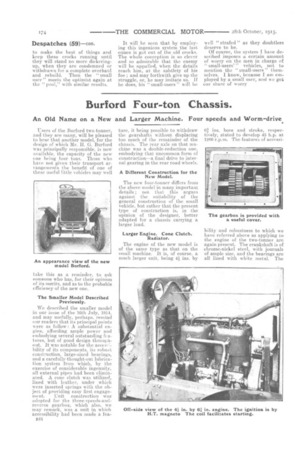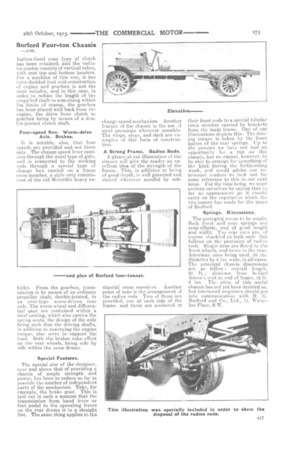Burford Four-ton Chassis.
Page 14

Page 17

If you've noticed an error in this article please click here to report it so we can fix it.
An Old Name on a New and Larger Machine. Four speeds and Worm-drive.
-Users of the Burford two-tonner, and they are many, will be pleased to hear that another model, for the design of which Mr. II. G. Burford was principally responsible, is now available, the capacity of the new one being four tons. Those who have not given their transport arrangements the benefit of one of these useful little vehicles may well
take this as a reminder, to ask someone who has, for their opinion of its merits, and as to the probable efficiency of the new one.
The Smaller Model Described Previously.
We described the smaller model in our issue of the 16th July, 1914, and may usefully, perhaps, remind our readers that its principal points were as follow : A substantial engine, affording ample power and embodying several outstanding features, but of good design throuiicut. It was notable for the acceslaility of its components, its robust construction, large-sized bearings, and a carefully-thought-out lubrication system from which, by the exercise of considerable ingenuity, all external pipes had been eliminated. A cone clutch was utilized, lined with leather, under which were inserted springs with the object of providing easy first engagement. Unit construction was adopted for the three-speeds-andreverse gearbox, which also, we may remark, was a unit in which accessibility had been made a Sea
n44 ture, it being possible to withdraw the gearshafts without displacing too much of the remainder of the .chassis. The rear axle on that machine was a double-reduction one, embodying that uncommon form of construction—a final drive to internal gearing in the rear road wheels.
A Different Construction for the New Model.
The new four-tonner differs from the above model in many important details ; not that this argues against the suitability of the general construction of the small vehicle, but rather that the present type of construction is, in the opinion of the designer, better adapted for a chassis carrying a larger load.
Larger Engine. Cone Clutch. Radiator.
The engine of the new model is of the same type as that on the small machine. it is, of course, a much larger unit, being 41 ins. by 61 ins, bore and stroke, respectively, stated to develop 45 h.p. at 1200 r.p.m. The features of accessi
bility and robustness to which we have referred above as applying to the engine of the two-tonner are again present. The crankshaft is of chrome-nickel steel, with journals of ample size, and the bearings are all lined with white metal. The leather-lined cone type of clutch has been retained, and the radiator-centre consists of vertical tubes, with cast top and bottom headers. For a machine of this size, it has been decided that unit construction of engine and gearbox is not the most suitable, and in this case, in order to reduce the length of the propelled shaft to something within the limits of reason, the gearbox has been placed well back from the engine, the drive from clutch to gearbox being by means of a double-jointed clutch shaft.
Four-speed Box. Worm-drive Axle. Brakes.
It is notable, also, that four speeds are provided and not three only. The change-speed lever operates through the usual type of gate, and is connected to the striking rods through a, special type of change box carried on a frame cross member, a style very reminiscent of the old lureretides heavy ye
hicles. From the gearbox, transmission is by means of an ordinary propeller shaft, double-jointed, to an over-type worm-driven rear axle. The worm wheel and differential gear are contained within a steel casting, which also carries the spring seats, the design of the axle being such that the driving shafts, in addition to conveying the engine torque, also serve to support the load. Both the brakes take effect on the rear wheels, being side by side within the same drums.
Special Features.
The special aim of the designer, over and above that of providing a chassis of ample strength and power, has been to reduce so far as possible the number of independent parts of the mechanism. Take, for example, the brake gear. This is laid out in slich a manner that the transmission from hand lever or foot 'pedal to the operating levers on the rear drums is in a straight line. The .same thing applies to the change-speed mechanism. Another feature of the chassis is the use of steel pressings wherever possible. The wings, steps, and dash are examples of this form of construction.
A Strong Frame. Radius Rods..
A glance at our illustration of the chassis will give the reader an excellent idea of the strength of the frame. This, in addition to being of good depth, is well gusseted and stayed wherever needful by sub stantial cross members. Another point of note is the arrangement of the radius rods. Two of these are provided, one at each side of the frame, and these are anchored at
their front ends to a special tubular cross member carried by brackets from the main frame. One of our illustrations depicts this. The driving torque is taken by the front halves of the rear springs. Up to the present we have not had an opportunity for a run on this chassis, but we expect, however, to be able to arrange for something of the kind during the forthcoming week, and would advise our interested readers to look out for some reference to this in our next issue. For the time being, we must content ourselves by saying that so far as appearances go it should carry on the reputation which the two-tonner has made for the name of Burford.
Springs. Dimensions.
The springing seems to be ample. Both front and rear springs are semi-elliptic, and of good length and width. The sear ones are, of course shackled at both ends this follows on the provisien of radius rods. Single tires are fitted to the front wheels, Find twins to the rear, American sizes being used, 3S ins. diameter by 5 ins, wide, in all cases. The principal chassis dimensions are as follow : overall length, 21 ft. ; distance from behind driver's seat to end of frame, 12 ft. 6 ins: The price of this useful chassis has not yet been decided on, but interested enquirers should get into communica,tion with H. G. Burford and Co., Ltd., 11, Waterloo Place, S.W.






















